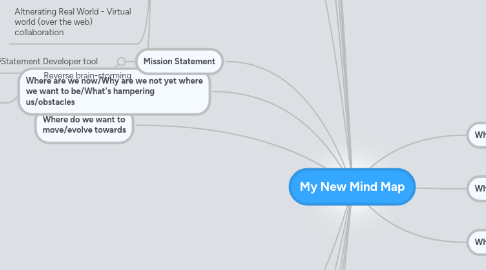
1. With whom and what's your roles/relations
2. How often
3. Why
4. SWOT
4.1. Strengths
4.2. Weaknesses
4.3. Opportunities
4.4. Threads
5. Where we came from/your background
5.1. Own resources
5.1.1. Human
5.1.2. Material
5.1.3. Location
5.1.4. Logistics
5.1.5. Diploma's
5.1.6. Languages
5.1.7. Curriculum Vitae
5.1.7.1. Your linkedin.com profile
5.1.7.2. EU Standard Curriculum Vitae
5.2. Resources by your family and friends
5.3. Resources by your network
6. Where do we want to move/evolve towards
7. Where are we now/Why are we not yet where we want to be/What's hampering us/obstacles
8. Mission Statement
8.1. use a Mission Statement Developer tool
9. Techniques
9.1. Open Space Techniques
9.2. mindmeister.com mindmapping and brainstorming tool compatible with google drive
9.2.1. To run a group brainstorming session effectively, do the following: Define the problem you want solved clearly, and lay out any criteria to be met. Keep the session focused on the problem. Ensure that no one criticizes or evaluates ideas during the session. Criticism introduces an element of risk for group members when putting forward an idea. This stifles creativity and cripples the free running nature of a good brainstorming session. Encourage an enthusiastic, uncritical attitude among members of the group. Try to get everyone to contribute and develop ideas, including the quietest members of the group. Let people have fun brainstorming. Encourage them to come up with as many ideas as possible, from solidly practical ones to wildly impractical ones. Welcome creativity. Ensure that no train of thought is followed for too long. Encourage people to develop other people's ideas, or to use other ideas to create new ones. Appoint one person to note down ideas that come out of the session. A good way of doing this is to use a flip chart. This should be studied and evaluated after the session. A good idea to start with is to let out the negative energy first by joking around what certainly not to do ... and turning this into more and more constructive arguements ...
9.2.2. Working with a group is working with energy. Often there's a lot of energy in a group.. everybody needs / wants to talk at the same time ... Solving this is simple: put a paper on the table, draw a large circle ... ask everybody to write down key-words of topics they want to discuss...
9.2.3. A more formalized brainstorming, i.e. when people come to a meeting and know it is for a brainstorming:
9.2.3.1. first get the energy flowing - e.g. with an ice-breaker game
9.2.3.2. secondly get all the negative energy out - e.g. let them write down everything that's bad, frustrations, why things don't work, all things / idea's that won't work or make sure the idea or ideas won't work
9.2.3.3. then turn the page ... and ask them to do the opposite from the negative: what inspires ? .... Happy brainstorming.
9.2.3.4. Prioritize the Brainstorming in a google docs so it can be shared with all and they can all continue working out their points
9.2.4. Spontaneous brainstorming
9.2.4.1. Sometimes in a group, all of a sudden everybody wants to speak/has to say/has idea's. Release and channel that energy, dont' hold it back: put a paper in the middle and ask all to write down whatever it is they want to share, so they won't forget it / the group won't miss any point as we agree to go over every point if necessary in follow-up meetings.
9.2.4.1.1. Prioritize the Brainstorming in a google docs so it can be shared with all and they can all continue working out their points
9.3. Mission Statement Developer tool
9.4. Altnerating Real World - Virtual world (over the web) collaboration
9.5. Reverse brain-storming
9.5.1. is a good technique to try when it is difficult to identify solutions to the problem directly..."reverse" questions: Instead of asking, "How do I solve or prevent this problem?" ask, "How could I possibly cause the problem?"
